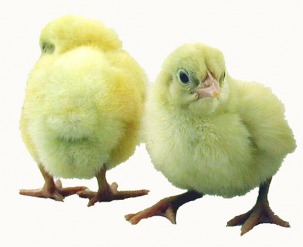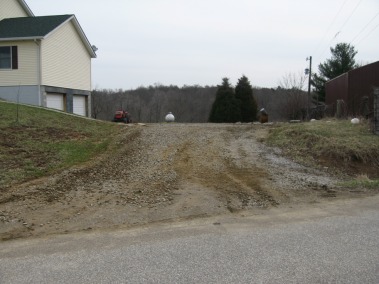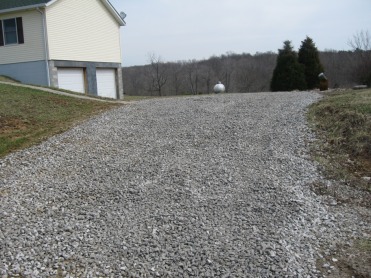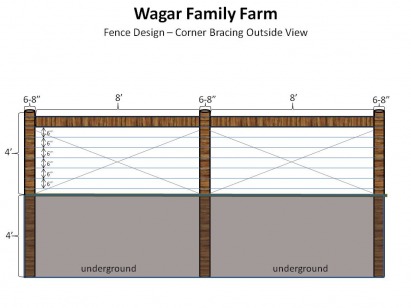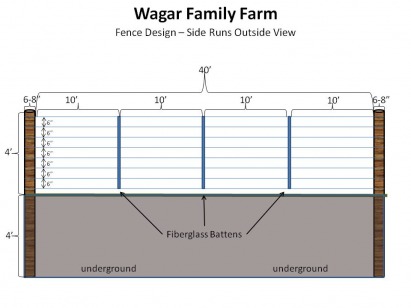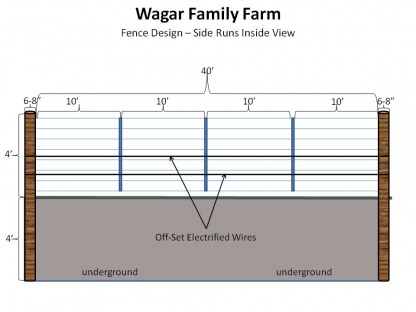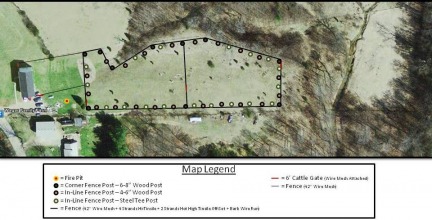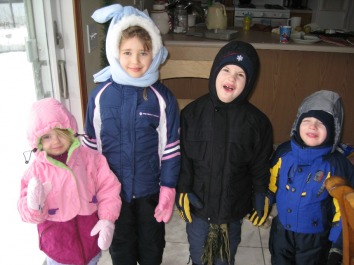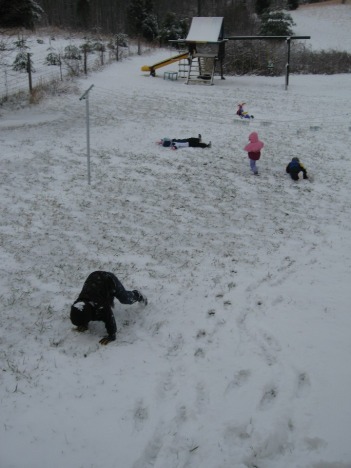Well if you read the latest post under the family tab (Guys Day Out), you may have expected to see a post similar to this one over here. (keep reading)
Do you remember seeing the post earlier this, or maybe it was late last year, about the coyote we saw on our property? Well I was talking with my neighbor to the north a couple of weeks ago and was sharing that we were planning to get some chickens in about a month. To this, he shared his story of getting chickens a few years back. He stated that he had built them a small pen and surrounded it with chicken wire, the next morning (after the first night out) he stated that he went out to check on them in the morning and there was chicken carnage. Apparently coyotes came in the night, chewed through the chicken wire and killed all of the chickens....
Not wanting to end up with the same outcome as my neighbor, and knowing that my pellet rifle wouldn't really do much other than make the coyotes mad, I purchased my first .22 rifle. (see picture below). It's a Ruger 10/22, the most purchased .22 in history.
Now before you grandparents start to give me a lecture on having a gun in the house with children, let me tell you that the ammunition is not kept with the gun ,and the gun, when not in use, has a trigger lock installed on it, meaning that the rifle cannot be loaded and the trigger cannot be pulled when it is installed.
In addition to the rifle, we are also purchasing a portable electric fence which should also deter any predators including coyotes from getting to the chickens.
Best case scenario, I will be only using it for target practice on the back 40, and as my kids get older using it who teach them how to shoot.
Worst case scenario, I will need to shoot a coyote, which means that we'll just need to stuff it and have a mascot for our school (Coyote Creek Christian Academy).
For the past year and a half we've called our homestead "The Wagar Family Farm" yet we've not raised any type of livestock. Don't get me wrong, we've been working very hard at getting our ducks in a row (no pun intended) in order to allow us to begin our dream of becoming semi-self-sufficient.
Well, the time has come, as of today, and arriving on or around the 19th of May, the Wagar Family Farm will be raising a flock (25) White Rock chickens. I purchased these chicks online (as if I shop anywhere else) at Murray McMurray Hatchery, a premier chicken and game foul hatchery located in Webster City, Iowa. Per their website here is a short description of the White Rock Hens:
"White Rock pullets are outstanding for egg production the entire year, and are especially desirable through the cold winter months when lighter breeds slack off. They lay a brown egg of fine quality and size. The rapid growth, white, easy-to- dress feathers, and golden yellow skin of the cockerels of our strain make them equally desirable. Raise some for the frying pan or roaster. They are compact and well fleshed at almost any age. They are all big birds, hens reaching 6 to 7 lbs. and cocks 8 to 9 lbs. A flock of these pure white birds ranging busily over a grassy field is one of the prettiest sights you will ever see. Baby chicks are a creamy white and may show a touch of gray smokiness."
For those of you that are unfamiliar with how raising chickens works here is a quick overview:
Week 1-5:
Chicks arrive and are corralled indoors under a heat lamp with plenty of water and food available to them.
Week 6-24
The chickens are now ready to be placed out on pasture. I will be blogging about a new mobile chicken coop that I will be building in the later weeks. This coop will be surrounded by a mobile electric fence which will help to keep the predators out (i.e. coyotes, dogs, cats, etc). As the names suggest all of these items are mobile so that we can move them around our property as needed. They will continue to feed and roost in the coop, however no eggs will likely be produced.
Week 25- 104
The chickens should now begin to lay superb brown eggs for the family to enjoy. On average starting between weeks 25 and 30 we should begin to received on average 1 egg per chicken per day. Based on many factors (food, light, heat, water, etc) this should continue for about 2 years at which point the egg production typically drops off and most of the birds (unless they are still producing high quality eggs) will become chicken soup or stew meat, as they are no longer at the quality needed for grilling etc.
What does this all mean?
By Christmas of 2008, the Wagar family should be one step closer to becoming self-sufficient by no longer needing to purchase eggs from either the grocery store or other local farmers. In addition, each year after we will plan to purchase an additional 25 chicks allowing for an endless supply of farm fresh eggs, and although we eat a lot of eggs, we should be able to begin selling to other local families who are looking to purchase a superior product, compared to grocery stores, for their families.
For more information on large-scale hatcheries, watch the video below.
Hopefully all of you are enjoying as nice of weather as we are here in southern Indiana, and all of us know what happens when the weather gets nice…..SPRING CLEANING.
For the Wagar farm, spring cleaning means a few different things. First and foremost, spring cleaning this year meant that we would for the first time have garbage pickup, YAHOO!!! You see, this may not seem like an extravigance to you, but when you live in the middle of nowhere, getting garbage pickup is better than having a gormet kitchen. This means no more dogs/racoons/cats digging through the trash, spreading it all over our 5 acres.
Secondly, spring cleaning means revamping the driveway. As you probably know, gravel driveways deterorate after a period of time (which in our case means about every three years. Needless to say with all of the rain we have had all winter, we’re down to dirt and mud. That will all change this weekend when the first of three 21 ton loads of gravel are going to be dropped off. That’s right, after the whole shabang is completed we’ll have spread 63 tons of gravel down in order to recreate our driveway. Now it sounds like (and is) a lot of gravel, but when you compare prices it’s cheap compated to the alternatives of blacktop or concrete (the blacktop estimate came in at $3500.00 ouch!!) at only $600.00 total.
Third, spring cleaning means tractor and yard tool maintenance, which in this case meant replacing the three mower blades off of my antique Woods RM-59 3-point hitch mower. Now this sounds much easier than it was…. Let’s just say it took about 3 hours, two men, a chain, breaker bar, and a 15/16 socket. Nonetheless, we won and the blades are off…now I just have to go drop the $55.00 to purchase and install the new ones.
All in all, it’s springtime, we’re loving it and doing all of these projects prepares our minds, bodies and equipment for all of the work ahead of us.
Praise God for warmer days more sunlight.
Well, it’s with great joy and praise to God that I write all of you today.
As many of you know, Jennifer and I have been planning to start our family farm for the past few years, but our financial ability to move forward with our dream had not yet caught up. As you have read in my previous blog entries, we had planned on this changing this year with our tax return and a bonus from work, and although both of these did come through in greater amounts than we had expected, God has a different plan for us…
You see, God has placed it upon both Jennifer and my heart to take the financial blessing that He has provided us and instead of purchasing more with it and starting our farm (by our plan), we we’re both convicted by the Holy Spirit (neither of us knew each other was being convicted of the same thing until we both talked to each other two nights ago) to instead take one more step to financial freedom and payoff our Van (God’s plan).
Although some may see this as a potential setback for our dream, we have complete faith in our awesome God, that He has better timing that we do for our dreams. And as an example of this, he is blessing us with the ability to start small and obtain chickens for this year. As for the rest of our animals, etc, we’ll just have to see what God’s plans are and what timing He sets forth for us.
So today, please join with the Wagar family as we give glory and praise to God for His wonderful guidance and leadership of our family.
Thanks be to God!
In anticipation to fence in approximately 2 of the 5 acres of our property, I have up to now used estimated dimensions based upon tools provided in Google Earth (free satellite imaging software available for download). As we get closer to actually purchasing the fencing components, I wanted a more accurate measurement of the area; hence this past Saturday I tied up my boots and headed out to the back 40.
....It was while I marked off the property using my 330' tape measure that I once again realized how blessed we are to have the opportunity to live in such a beautiful area, it really shows Gods creation in a magnificent way. We should all take some time to reflect on God's wonderful creation that just happens to be surrounding us at all times but that we almost always take for granted....
Anyway, after about an hour and a half of walking around and marking the property it was time to begin my calculations, here are the results:
Total Fence Length = 2,100 Linear Feet Total Wire Needed = 21,000 Linear Feet Total Number of Posts Needed = 120
By the way if you are interested in knowing how accurate the Google Earth tool is, my estimate via Google Earth said that I would be at 2000 linear feet of fence. (not bad at all for estimates)
Next steps for me, continue to pray to ensure this is the direction God wants us to go, wait for our tax return, and move the direction of Gods' prompting.
Stay tuned and find out what we're going to do next!!
As knowledge and Wisdom increase, project requirements change and that is exactly what has happened in the case of our Fencing project. Since we're new to this whole farm thing we know that we're going to make some mistakes along the way, however many of these mistakes can be avoided by speaking with and learning from those who are wiser. In this case our changes have come from our asking other local farmers what they suggest we do with the fence. In this case it's a win/win situation for us as we have not yet started and the overall cost of the fence should be reduced based upon the changes.
As you may be aware (if you have read my previous fence blog posting) we were planning on a 4 piece fence (barb wire, woven wire, high tensile - non electrified, and high tensile - electrified), however our new approach, again based upon the knowledge of multiple farmers who have done this many times is a two piece fence consisting of 8 lines of high tensile - non electrified on the outside of the fence and two-offset lines of high tensile - electrified on the inside (see diagrams below for more details).
Some of the advantages of this style fence are: You use fewer fence posts (1 per 40 feet on flat ground), The high tensile wire is much less expensive and easier to install than wire fence, and the wires are much easier to stretch and keep tight, vs. the woven wire.
So looks like we're moving forward on this project, it's now time to add up the costs and make some purchases....
Keep coming back for more updates!!
As winter sets in, the planning begins for the next year of our renovation from a residential home to Hobby Farm. The first order of business this spring is fencing. Although the entire perimeter of our property is currently fenced with 4' woven wire, the wire is many years old (estimates are around 15+ years) and most of it is now rusted. In fact there are some areas near the back of the property where the fence is down due to fell trees. So nonetheless, a new fence is in order.
As you can see below in the photo, we'll be fencing in about two acres and segregating that into 1 acre paddocks. This will allow for rotational grazing of the goats, chickens and pigs. In addition within the paddocks we will most likely have one or two portable electric net fences which will allow us to further subdivide the area as necessary.
As for the construction of the perimeter fence, (I will describe it from bottom to top - i.e. ground up) we will be utilizing a 4 part fence. Part 1 consists of 1 bead of barbed wire along the ground, this is used for two primary purposes. First this will help to deter dogs and coyotes from attempting to enter the paddocks via trying to dig under the fence. Part 2 of the fence is 42" woven wire, which will act as the primary barrier seperating the outside and the inside of the paddock. The third layer will consist of 4 strands of high-tinsile wire (non-electrified) which will help to eleviate dogs, coyotes, Deer and other animals from jumping over the fence. Last but not least, the 4th layer of the fence consists of 2 strands of high-tinsile wire (electrified) which will be off set (to the inside of the fence) and located at 20" and 35" off of the ground. The primary purpse of this layer is to ensure that the goats stay inside of the fence.
As for the actual construction of the fence, I and some brothers in Christ will be doing as much of the construction as possible and although this will be both time consuming and labor intensive, the overall cost savings is significant.
As I begin to purchase the fence materials and startig the construction I will post more about the endevor.
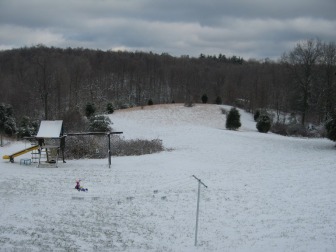
Winter is pretty quite here on the farm, that is from a farming perspective...but the kids make up for the quite by giggling and having fun in the snow.
Oh...and what about the fourth child in the picture below? He's a friend of the family's child who is staying with us while they are on vacation...
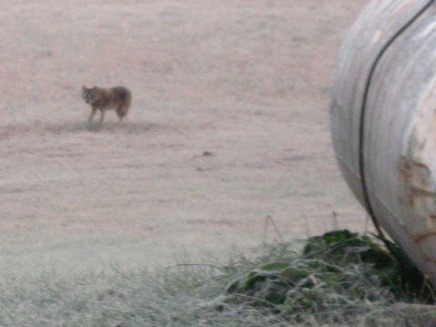
It may be hard to see in this photo, but here something you don't want to see on your farm, especially in the daytime when you are leaving for church. That's right, it's an approximately 100lb coyote. This photo was taken from 50 yards away. (hmmmm... I was wondering why we hadn't seen any rabbits lately...) Well, needless to say, if he stays around after we get our chickens, pigs and goats, he will end up as artwork in the house if you know what I mean. For now though, he is just awesome to look at.

